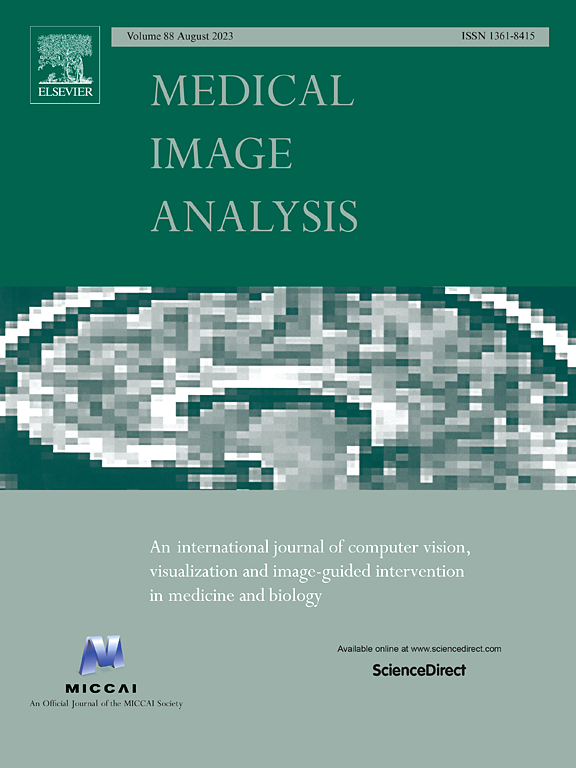AI-based association analysis for medical imaging using latent-space geometric confounder correction
IF 10.7
1区 医学
Q1 COMPUTER SCIENCE, ARTIFICIAL INTELLIGENCE
引用次数: 0
Abstract
This study addresses the challenges of confounding effects and interpretability in artificial-intelligence-based medical image analysis. Whereas existing literature often resolves confounding by removing confounder-related information from latent representations, this strategy risks affecting image reconstruction quality in generative models, thus limiting their applicability in feature visualization. To tackle this, we propose a different strategy that retains confounder-related information in latent representations while finding an alternative confounder-free representation of the image data.
Our approach views the latent space of an autoencoder as a vector space, where imaging-related variables, such as the learning target (t) and confounder (c), have a vector capturing their variability. The confounding problem is addressed by searching a confounder-free vector which is orthogonal to the confounder-related vector but maximally collinear to the target-related vector. To achieve this, we introduce a novel correlation-based loss that not only performs vector searching in the latent space, but also encourages the encoder to generate latent representations linearly correlated with the variables. Subsequently, we interpret the confounder-free representation by sampling and reconstructing images along the confounder-free vector.
The efficacy and flexibility of our proposed method are demonstrated across three applications, accommodating multiple confounders and utilizing diverse image modalities. Results affirm the method’s effectiveness in reducing confounder influences, preventing wrong or misleading associations, and offering a unique visual interpretation for in-depth investigations by clinical and epidemiological researchers. The code is released in the following GitLab repository: https://gitlab.com/radiology/compopbio/ai_based_association_analysis.
基于人工智能的医学影像关联分析——基于潜在空间几何混杂校正
本研究解决了基于人工智能的医学图像分析中混淆效应和可解释性的挑战。虽然现有文献通常通过从潜在表示中去除混杂相关信息来解决混淆,但这种策略可能会影响生成模型中的图像重建质量,从而限制了它们在特征可视化中的适用性。为了解决这个问题,我们提出了一种不同的策略,在寻找图像数据的替代无混杂表示的同时,在潜在表示中保留与混杂相关的信息。我们的方法将自编码器的潜在空间视为向量空间,其中与成像相关的变量,如学习目标(t)和混杂(c),具有捕获其可变性的向量。通过寻找与混杂相关向量正交但与目标相关向量最大共线的无混杂向量来解决混杂问题。为了实现这一点,我们引入了一种新的基于相关的损失,它不仅在潜在空间中执行向量搜索,而且还鼓励编码器生成与变量线性相关的潜在表示。随后,我们通过沿无混杂矢量采样和重建图像来解释无混杂表示。我们提出的方法的有效性和灵活性在三个应用中得到了证明,包括多个混杂因素和利用不同的图像模式。结果证实了该方法在减少混杂因素影响,防止错误或误导性关联方面的有效性,并为临床和流行病学研究人员的深入调查提供了独特的视觉解释。代码在以下GitLab存储库中发布:https://gitlab.com/radiology/compopbio/ai_based_association_analysis。
本文章由计算机程序翻译,如有差异,请以英文原文为准。
求助全文
约1分钟内获得全文
求助全文
来源期刊

Medical image analysis
工程技术-工程:生物医学
CiteScore
22.10
自引率
6.40%
发文量
309
审稿时长
6.6 months
期刊介绍:
Medical Image Analysis serves as a platform for sharing new research findings in the realm of medical and biological image analysis, with a focus on applications of computer vision, virtual reality, and robotics to biomedical imaging challenges. The journal prioritizes the publication of high-quality, original papers contributing to the fundamental science of processing, analyzing, and utilizing medical and biological images. It welcomes approaches utilizing biomedical image datasets across all spatial scales, from molecular/cellular imaging to tissue/organ imaging.
 求助内容:
求助内容: 应助结果提醒方式:
应助结果提醒方式:


